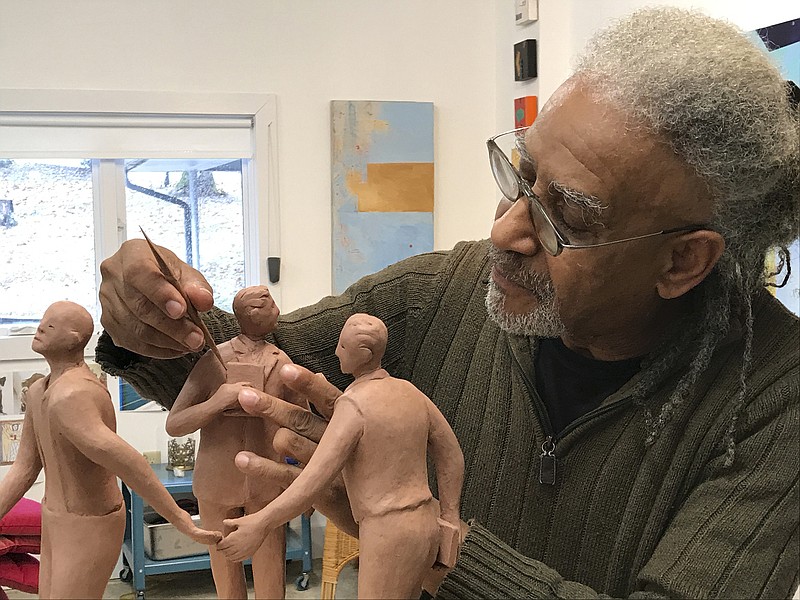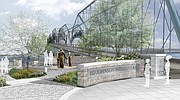Ed Johnson is stepping away from the Walnut Street Bridge, slightly ahead of Noah Parden to his right and Styles Hutchins to his left.
Hutchins is reaching for Johnson's hand but not connecting. And behind Johnson's foot, on the ground, is a noose.
The simple grouping of statues is the distillation of an old injustice that nonetheless led to progress; an old stain on Chattanooga's history that also marks new efforts toward unity and reconciliation.
The design, by Savannah, Ga., artist Jerome Meadows, has been chosen for the Ed Johnson Memorial by a local committee that is raising more than $500,000 for the project. The formal announcement will be made Monday at the Bessie Smith Cultural Center.
Memorial team
› Jerome Meadows, whose Meadowlark Studios design and create large-scale public art projects throughout the United States› Mike Fowler and Aaron Sugart-Brown, Ross/Fowler Landscape Architecture of Knoxville› Jan Chenoweth and Roger Halligan, Chattanooga artists, sculptors and consultants› Charlie Anderson, Full Circle Stoneworks› Leslee Ames, communications and project advancement
Johnson, a black man, was lynched from the bridge in 1906 after being accused of raping a white woman. The memorial project aims to honor an innocent victim of mob violence as well as the historic achievements of two attorneys whose work on his behalf has echoes into the present day.
"The Johnson case is important in so many ways, highlighting the contributions of the attorneys and the impact this case had on the American justice system," said LaFrederick Thirkill, who has worked for 18 years studying the case and raising money for scholarships and a documentary.
The case "spans time," Thirkill said. "It's just as impactful in the lives of people as it has been for 112 years, and it will continue to impact lives 112 years from now."
Contacted by phone Friday, Meadows said he is "delighted" to have been selected. His vision for the memorial is as a "sacred space where people could come and contemplate the meaning and message of Ed Johnson's story" as well as highlight the city's history, particularly for blacks.
Meadows explained the symbolism of the statutes: Johnson has his back to the second span of the bridge, the place where he was lynched.
Parden is looking back at the bridge, carrying a document labeled "U.S. Supreme Court." Defending Johnson, Parden became the first black American to argue as lead counsel before the high court.
And Hutchins, Johnson's other attorney and the first black lawyer to practice in Georgia, can't grasp his client's hand because "the mob overruled their efforts," Meadows said.
According to the book "Contempt of Court" by former Chattanooga Times reporter Mark Curriden and the late attorney Leroy Phillips, the Johnson case marked the first time in history the Supreme Court gave a stay of execution.
It was the first and only time the Supreme Court held a criminal trial, which ended with Hamilton County Sheriff Joseph F. Shipp being held in contempt of court. The justices said Shipp failed to keep Johnson safe, noting some of his deputies took part in the lynching, according to the book.
The life-sized statues will be placed on the south end of the bridge, surrounded by stone walls. Downslope toward the Tennessee River will be reminders of three other Chattanooga lynchings, including the murder of Alfred Blount on the same bridge.
Thirkill said he learned about Johnson when Phillips showed him the man's grave in an abandoned cemetery. He said talks about doing something at the bridge to honor Johnson's memory started about 2005.
Ed Johnson Project coordinator Mariann Martin said about $300,000 has been raised, and that several major donors are poised to give when they see the final design. The memorial will cost about $400,000 and another $100,000 will go to complete a documentary on Johnson by filmmaker Linda Duvoisin. The final $25,000 will go for scholarships administered by the Community Foundation.
Martin said she learned about Johnson by reading "Contempt of Court," and was so moved she began teaching it in English classes at Virginia College.
"I saw the students' responses and they got angry," Martin said. "'We grew up in Chattanooga, why hasn't anyone told us this story?'"
Over time, she said, the various threads of interest in Johnson coalesced around the idea of a memorial. But it's become a lot more than stone figures on a plaza.
"The thing we weren't expecting was the community aspect of this," Martin said.
The Johnson Project group began holding community meetings, showing a rough cut of Duvoisin's documentary and telling the story. Nearly 3,000 people have attended more than 40 events to date in churches, homes and other places, she said.
"It usually turns into conversations about race and healing and how this has hurt Chattanooga by not talking truthfully about the past," Martin said.
"It's very touching. There are a lot of people here, both black and white, who are looking for ways to bring their community together and find some healing, and I think this Ed Johnson story has been the catalyst to sort of do that."
Added Thirkill, "You can't get to reconciliation without going to the truth."
Contact staff writer Judy Walton at jwalton@timesfreepress.com or 423-757-6416.

